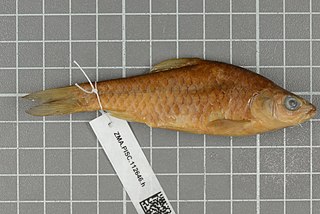
Coregonus lavaretus is a species of freshwater whitefish, in the family Salmonidae. It is the type species of its genus Coregonus.
Pelasgus epiroticus, or tsima, is a species of freshwater minnow in the family Cyprinidae. It is endemic to lake Pamvotis in Greece. Due to the restricted range of the species as well as the significant loss its population suffered since the early 1990s it has been assessed as critically endangered by the International Union for Conservation of Nature (IUCN).

Poropuntius tawarensis is a species of cyprinid fish. It endemic to Lake Tawar in Aceh Province, northern Sumatra, Indonesia.

Poropuntius is a genus of cyprinid fish found mainly in freshwater habitats of Southeast Asia and Yunnan in China, but P. burtoni is from South Asia. Several species have highly restricted ranges and are threatened, and a single P. speleops is a cavefish.
Maurice Kottelat is a Swiss ichthyologist specializing in Eurasian freshwater fishes.

Betta is a large genus of small, active, often colorful, freshwater ray-finned fishes, in the gourami family (Osphronemidae). The best known Betta species is B. splendens, commonly known as the Siamese fighting fish and often kept as an aquarium pet.

Fuxian Lake stretches out through Chengjiang, Jiangchuan and Huaning Counties in Yunnan Province, spanning an area of 212 square kilometers. The lake is ranked third-largest in Yunnan, after Dian Lake and Erhai Lake. Also the deepest lake in Yunnan, it is 155 meters deep at its greatest depth. It is also the third-deepest fresh water lake in China, after Tianchi and Kanas Lake.
Poropuntius angustus is a species of cyprinid fish. It is endemic to the Mekong Basin and is currently only known from a few tributaries of Mekong in Laos. It grows to 12 cm (4.7 in) SL. It lives mainly in small forest streams.
Poropuntius bolovenensis is a species of ray-finned fish in the genus Poropuntius. This species is endemic to the eastern half of the Boloven Plateau in southern Laos where its numbers are decreasing under heavy fishing pressure. However, the biggest threat to this species is the construction of dams which are likely to have a significant impact on this species. In addition the quality and area of its habitat is declining due to conversion for agriculture. The IUCN assess P. bolovensis as Endangered. This species occurs in clear, rocky streams at altitudes of 800–1,200 m above sea level where it feeds mainly on insects. It does not thrive in reservoirs. It is not a true migrant but it does make local movements. It is targeted by subsistence fisheries.
Poropuntius burtoni is a species of ray-finned fish in the genus Poropuntius which is common in most of the hils treams draining into the Chindwin river in Manipur.
Poropuntius carinatus is a species of ray-finned fish in the genus Poropuntius from the upper Mekong drainage in Yunnan, Laos, Thailand and probably Myanmar.
Poropuntius exiguus is a species of ray-finned fish in the genus Poropuntius that is endemic to Lake Erhai in China. It has not been recorded since the 1970s and it is possibly extinct.
Poropuntius krempfi is a species of ray-finned fish in the genus Poropuntius from the Red River drainage in Vietnam and Yunnan, and from the Ma River drainage in Vietnam and Laos.
Poropuntius lobocheiloides is a species of ray-finned fish in the genus Poropuntius which is endemic to tributaries of the Xe Kong River on the eastern half of the Bolovens Plateau in southern Laos. Its numbers are thought to be decreasing due to heavy fishing pressure, but the biggest threat to this species are the planned dams, Xe Pian and Xe Namoy, which are to be built within the next few years and which are likely to have a significant impact on this species. In addition, there is continuing decline in the quality as the surrounding land is converted to agriculture. The IUCN assess Poropuntius lobocheiloides as Endangered.
Poropuntius solitus is a species of freshwater, ray-finned fish in the genus Poropuntius. It was first described by Maurice Kottelat in 2000. This species is found in tributaries to the Xe Kong River on the eastern half of the Bolaven Plateau in Laos. Its population is decreasing due to overfishing, and proposed efforts to dam the river and its tributaries further threaten the species. The Poropuntius solitus is currently considered an endangered species by the International Union for Conservation of Nature and Natural Resources.

Gyrinocheilus aymonieri is a freshwater fish native to large parts of Southeast Asia. It is of interest as a local food source and for the aquarium trade. Its common names include honey sucker, sucking loach and Chinese algae eater.
Datnioides microlepis, also known as the Indonesian tiger perch, Indo datmoid, Indonesian tigerfish, or finescale tigerfish, is a species of freshwater fish endemic to the Malay Peninsula and Indonesia. Previous records from the Chao Phraya and Mekong rivers is due to confusion with the D. pulcher, which was included in D. microlepis until 1998. It reaches up to 45 cm in length. This fish is commonly seen in the aquarium trade, and often is seen when juvenile about 3–4 in (8–10 cm) long.
Devario gibber is a freshwater fish endemic to the Xe Kong and Xe Don basins in Laos. It occurs in stone-bottomed, clear streams with moderately fast to rapidly flowing water, and is uncommon in floodplains. It is caught in local subsistence fisheries, but not believed to be substantially impacted by them.
Devario salmonata is a freshwater fish endemic to the Xe Kong drainage in Laos.
Speolabeo musaei is a species of cyprinid cavefish endemic to the Xe Bang Fai River in Laos. It is the only species in the genus Speolabeo, but it was formerly included in Bangana.






